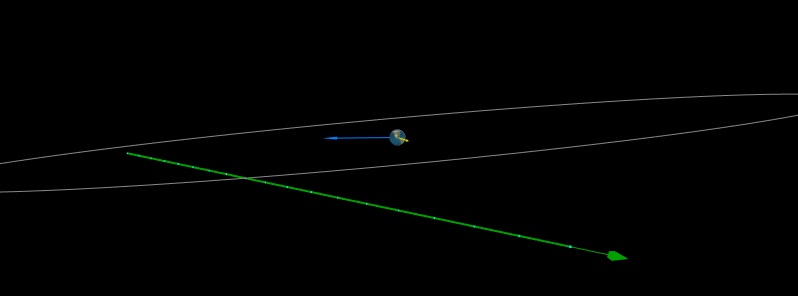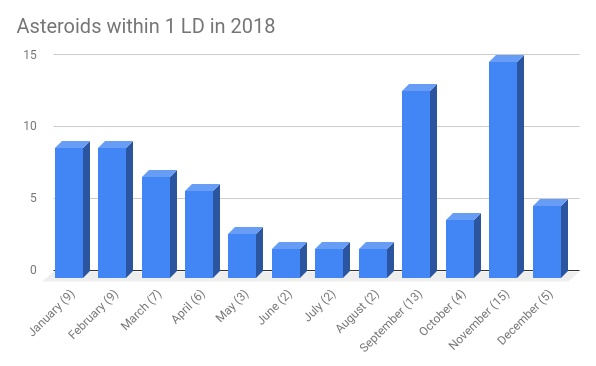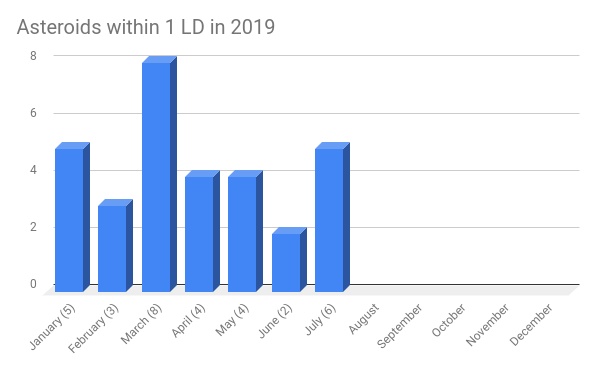Asteroid 2019 OK to flyby Earth at 0.19 LD on July 25 – the largest of the year

A newly discovered asteroid designated 2019 OK is expected to flyby Earth at a distance of just 0.19 LD / 0.00048 AU (71 806 km / 44 618 miles) at 01:22 UTC on July 25, 2019. This object is slightly bigger than today's 2019 OD, making it the largest known asteroid to flyby Earth within 1 lunar distance since the start of the year.
The object belongs to the Apollo group of asteroids. It was first observed at SONEAR Observatory, Oliveira, Brazil on July 24, 2019.
Its estimated diameter is between 57 and 130 m (187 – 426 feet).
Close approach is expected at 01:22 UTC at a speed (relative to the Earth) of 24.5 km/s.
MPC "U" parameter (orbit uncertainty estimate 0-9, with 0 being good, and 9 being highly uncertain) is 7.
[ Ephemeris | Orbit Diagram | Orbital Elements | Physical Parameters | Close-Approach Data ]
| NEO | DATE / TIME UTC | DISTANCE LD | AU | Diameter (m) | ||||
| 2019 OK | July 25 @ 01:22 ± < 00:04 | 0.19 | 0.00048 | 57 – 130 | ||||
| 2019 OD | July 24 @ 13:31 ± 00:04 | 0.93 | 0.00239 | 54 – 120 | ||||
| 2019 NN3 | July 10 @ 16:29 ± < 00:01 | 0.83 | 0.00214 | 35 – 77 | ||||
| 2019 NF7 | July 9 @ 12:07 ± < 00:01 | 0.98 | 0.00253 | 6.4 – 14 | ||||
| 2019 MB4 | July 9 @ 07:20 ± < 00:01 | 0.82 | 0.00211 | 17 – 38 | ||||
| 2019 NK1 | July 2 @ 09:48 ± 00:05 | 0.69 | 0.00177 | 2.9 – 6.5 | ||||
| 2019 LW4 | June 8 @ 17:04 ± < 00:01 | 0.65 | 0.00166 | 9.3 – 21 | ||||
| 2019 LY4 | June 6 @ 01:30 ± < 00:01 | 0.22 | 0.00056 | 7.3 – 16 | ||||
| 2019 KT | May 28 @ 03:48 ± < 00:01 | 0.85 | 0.00217 | 13 – 29 | ||||
| 2019 JH2 | May 16 @ 00:06 ± < 00:01 | 0.19 | 0.00048 | 3.1 – 7 | ||||
| 2019 JY2 | May 5 @ 17:12 ± < 00:01 | 0.38 | 0.00098 | 3.3 – 7.3 | ||||
| 2019 JX1 | May 2 @ 12:39 ± 00:02 | 0.47 | 0.00120 | 3.8 – 8.6 | ||||
| 2019 JK | April 30 @ 08:12 UTC ± 00:01 | 0.69 | 0.00178 | 7.1 – 16 | ||||
| 2019 HE | April 20 @ 21:12 ± < 00:01 | 0.58 | 0.00149 | 13 – 30 | ||||
| 2019 GC6 | April 18 @ 06:39 ± 00:29 | 0.57 | 0.00147 | 13 – 28 | ||||
| 2019 GN20 | April 12 @ 07:06 ± < 00:01 | 0.98 | 0.00253 | 14 – 31 | ||||
| 2019 FP21 | March 31 @ 19:00 ± 07:46 | 0.93 | 0.00238 | 3 – 6.6 | ||||
| 2019 FV1 | March 31 @ 05:27 ± < 00:01 | 0.87 | 0.00223 | 4.6 – 10 | ||||
| 2019 FC1 | March 28 @ 05:46 ± < 00:01 | 0.27 | 0.00069 | 20 – 45 | ||||
| 2019 FQ | March 23 @ 18:17 UTC ± < 00:01 | 0.86 | 0.00220 | 10 – 23 | ||||
| 2019 EA2 | March 22 @ 01:53 UTC ± 00:02 | 0.80 | 0.00205 | 18 – 40 | ||||
| 2019 FA | March 16 @ 01:14 UTC ± < 00:01 | 0.60 | 0.00154 | 4.9 – 11 | ||||
| 2019 EN2 | March 13 @ 23:38 UTC ± < 00:01 | 0.86 | 0.00221 | 8 – 18 | ||||
| 2019 EH1 | March 1 @ 17:38 UTC ± < 00:01 | 0.06 | 0.00016 | 2.5 – 5.7 | ||||
| 2019 DF | February 26 @ 21:21 UTC ± 00:09 | 0.47 | 0.00120 | 3.0 – 6.7 | ||||
| 2019 DG2 | Febraury 26 @ 07:39 UTC ± 07:39 | 0.61 | 0.00158 | 5.4 – 12 | ||||
| 2019 CN5 | February 11 @ 07:23 UTC ± 00:03 | 0.31 | 0.00079 | 7.3 – 16 | ||||
| 2019 BZ3 | January 27 @ 23:29 ± < 00:01 | 0.13 | 0.00032 | 4.8 – 11 | ||||
| 2019 BV1 | January 24 @ 20:53 ± < 00:01 | 0.35 | 0.00090 | 4.8 – 11 | ||||
| 2019 BO | January 16 @ 01:13 ± 00:02 | 0.18 | 0.00046 | 6.3 – 14 | ||||
| 2019 AE9 | January 12 @ 11:09 ± < 00:01 | 0.26 | 0.00067 | 9.9 – 22 | ||||
| 2019 AS5 | January 8 @ 00:37 ± < 00:01 | 0.04 | 0.00010 | 0.92 – 2.1 | ||||




References
Asteroid 2019 OK at CNEOS; at Minor Planet Center
Featured image credit: MPC

Such a pity it was not destroyed everything.
I believe I may have footage of an asteroid I dont really know, as I’m not a professional. But I’d like to show a professional to verify it.
Is your footage of this one? https://www.amsmeteors.org/members/imo_view/report/76090 I saw this one but have been unable to get video or pictoral confirmation. My first calculation made it about 600 to 1000 feet in diameter. That was too rough, I redid the numbers and the smallest I can make it is 1000 feet to 1 mile in diameter. It came close enough to hit the atmosphere, 30 to 70 iles away. A physisist could get it more accurate if I could explain the shock waves formed. There were two, one was the leading edge, the second was the rim of a very large crator. It was Iron, had the orange hue of the leonids. I think it was know because of a lot of circumstantial evidence I found. Need a picture!
Ummm?! Am I missing something? I reached this site from a news story on “The Blaze” which claimed they didn’t see it coming partly because it came from the Sun towards Earth, analogizing trying to catch a “pop” fly at noon. The illustration clearly shows the asteroid approaching from the opposite side. Is this a fake story???
Not fake. It was discovered a day before close approach.
Yes,but if you look at the diagram.of the orbits,it shows 2019 OK approaching from the outer planets not the Sun.I believe this is what he meant.I to saw this and was trying to understand.So if there is an explanation please share.
NASA is not needed to monitor these NEOs, and they are obviously not doing it.
Why depend on the gubmint for everything?
Like you said, they are too busy fighting useless wars for their political agendas, so they don’t have the resources for NEO monitoring.
Most of the NEO monitoring is done by non-government observatories.
It was a Brazilian observatory that first found 2019 OK, just the day before it passed by.
This just shows that the so called ‘experts’ have no clue and were surprised by this like so many other near misses. They will also miss the next one too.
It is just a matter of time before one of these near misses is a hit.
If this is Gods universe then he is sending us a sign that we are not looking through the correct lens to find Jesus…
What makes you think Jesus _didn’t_ save the Earth from the asteroid?
The powers that be decided to defund NASA when it’s more important next to health care then anything.Why so Corporations and Banks can own outer space and to hide fundemental truths about the Moon, UFOs and our place in the universe. Also to conceal the fact they want to have all the mineral rights.
We need NASA more then anytime in history besides finding astroids and ways to prevent collisions with earth.If cost is the reason they dismantled NASA then it’s o.k to spend 30 billion a month on the war in Iraq, or a unaccountable 800 billion annually on defence.Whsts wrong with this picture.Or the billions spent on Geoengineering which is killing us all aby putting nano aluminum into our drinking water around the world.Which is unfixable.
Maybe the same people want a catastrophy so they can say it’s an apocolyps.
Biocondeieos…
Jim, do you have strong, reliable sources about your post. I seek for the truth also but I don’t usually believe what people say but your post is interesting.
Well, if NASA was that important maybe Bill Gates would donate his 100’s of Billions of them instead of wherever he’s giving it. I would think the Gates Foundation would understand all threats facing Earth and put money towards NASA. My guess is even if we had a 6 month head start, we can’t stop an asteroid. I don’t think we ever even went to the Moon, so we don’t have the technology to travel deep into space with Human Craft yet
Hey, why pick on Bill Gates ? He’s donating his personal wealth for the public good – why not ask Rupert Murdoch ? He’s rich. Or maybe petition Apple ?